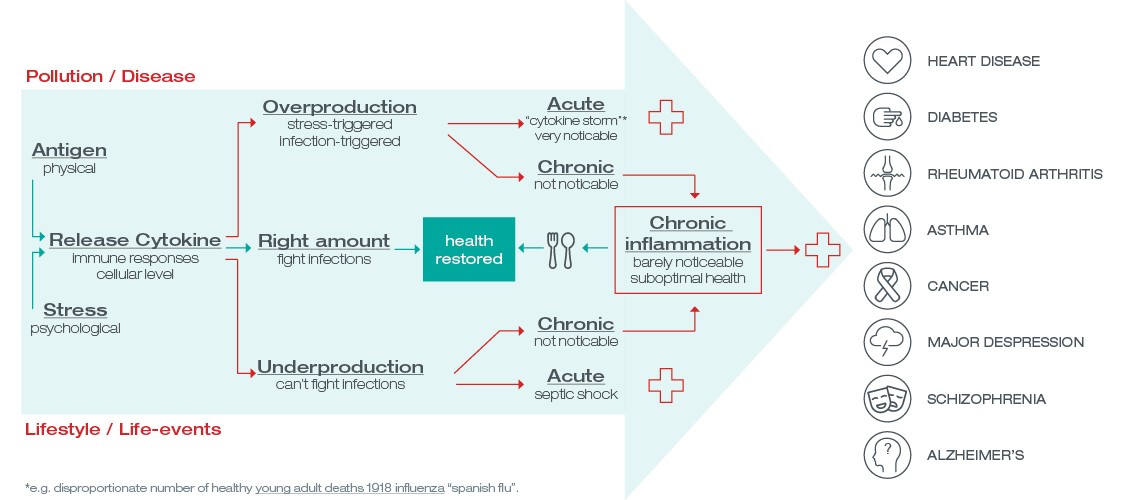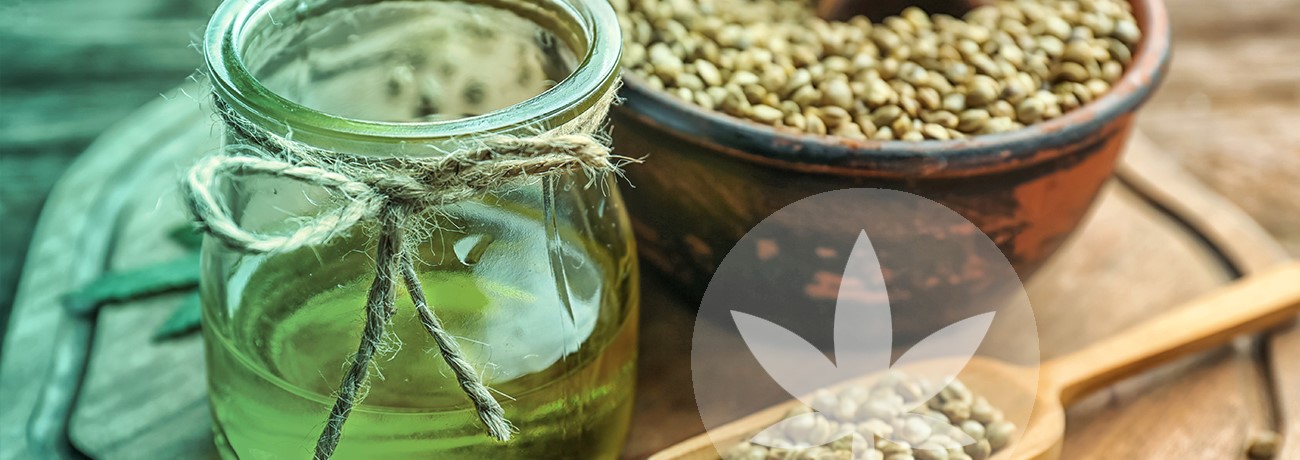Understanding Chronic Inflammation—The Key to Preventing All Lifestyle Diseases
Last updated:
Published:
Chronic inflammation—the big problem we fail to see
Diabetes, high blood pressure, heart disease, rheumatoid arthritis, even cancer—they may all have one thing in common: chronic inflammation (CI). We still don’t know the exact reason why these conditions occur, but science believes that chronic inflammation may be a significant contributing factor to their onset. CI happens when there is a buildup of inflammatory cells that continue doing their job, even though an infection has passed or been dealt with. Allow us to explain.
First, let's start with our inflammatory response. When you cut your leg, get a sore throat, or sprain an ankle, the area surrounding the injury swells, filling with blood and feeling warm to the touch. This is our inflammatory response. Our body is sending a combination of white blood cells, fluid, and proteins to an area of our body that needs repair.
If you damage your car, a mechanic fixes it. If we damage our body, our immune system comes to our aid, containing any potential infection. Low-level inflammation can also be referred to as “suboptimal health”. You are not at your best when your body is putting energy into fighting an infection.

What is chronic inflammation?
Once the damage is contained and the risk of infection has passed, those white blood cells either die-off or return to what they are doing, ready to act if another injury occurs. Chronic inflammation begins when the infection doesn't pass, or the collection of cells that arrived to deal with the problem become "confused" and fail to disperse, causing a buildup.
When white blood cells arrive at an injury, they are hardwired to deal with inflammation. They start tackling any damage or infected cells, acting as our immune system should. However, once the infection is dealt with, if the abundance of inflammatory white blood cells still exists, they will start attacking healthy cells. The continued buildup causes our immune system to think there is still an issue to deal with, hence white blood cells becoming overzealous.
When this scenario occurs, you have the beginnings of chronic inflammation. Without any remedial action, cells can spiral even further out of control, and have the potential to contribute to the development of certain types of cancer, or the other diseases we mentioned earlier.
Cytokines, the double-edged sword
You may be wondering, what makes a cell become confused or causes it to attack healthy cells? The answer is cytokines.
Cytokines are small protein cells responsible for delivering messages to a variety of cells, including white blood cells. They occur in nearly every biological process, but play a critical role in our immune system. Cytokines can be split into two camps, proinflammatory and anti-inflammatory. We need the right balance of both to make sure our immune system operates properly. Remember, if there were no inflammatory response, we would not be able to fight an infection or virus.
Cytokines, depending on which camp they belong to, will deliver a message that tells white blood cells how to act. If an overproduction of proinflammatory cytokines occurs, you end up in a scenario where white blood cells become overzealous, attacking healthy cells. Cells become confused and can continue thinking there is an infection to fight when there isn't.
With too many anti-inflammatory cytokines present, our body won't be able to fight back effectively when we get a virus or infection. Healthy humans need a balance of cytokines, telling our immune system to take action when we need it, but then backing off when we don’t.
The infographic below breaks down what can happen if you have too many proinflammatory cytokines, a balance that is just right, or a buildup of anti-inflammatory cytokines.

Chronic inflammation—the good news in disguise
The topic of chronic inflammation may sound very daunting, especially as it has the potential to be a precursor to chronic diseases. The World Health Organization ranks chronic disease as the greatest threat to human health. They anticipate that the association between chronic diseases and chronic inflammation will increase over the next 30 years, affecting millions of people.
Don't panic though!
If we know that chronic inflammation can lead to diabetes, heart disease, arthritis, and allergies, then that means by dealing with CI from the get-go, we may be able to prevent these conditions from ever occurring. Once diabetes or heart disease have been diagnosed, they can be incredibly difficult to treat. Chronic inflammation, on the other hand, is significantly easier to keep in check.
Our diet has a massive impact on the production of proinflammatory and anti-inflammatory cytokines that in turn tell our cells what to do. By improving our health with the right foods, we can maintain their balance, effectively fighting back against the risk of chronic inflammation.
Foods to avoid
Trying to avoid these types of foods altogether will provide the best results; however, limiting our consumption is also beneficial. Each one encourages an inflammatory response:
• Fried foods: Including chips, chicken, and onion rings
• Refined carbohydrates: White bread, certain types of pasta, pastries
• Soft drinks: Including any other sugar-sweetened drinks
• Red meat: Steaks fall under this category, but so do processed meats like hot dogs and canned goods
• Margarine or lard
Foods to include
The following are beneficial to our health, helping our body effectively detox. These should be included as part of an anti-inflammation diet wherever possible. A simple rule of thumb for maintaining a healthy balance of cells is to do as our prehistoric ancestors would. Referred to as the paleo diet, it means eating natural foods that cavemen would have had to hunt or gather. Each one encourages anti-inflammatory effects:
• Tomatoes
• Nuts: Including walnuts and almonds
• Fatty fish: Types that are rich in omega-3, such mackerel, tuna, and salmon
• Fruits: Oranges, cherries, strawberries, or blueberries
• Olive oil
• Hemp seed oil
Hemp nutrients, the new light
The last suggestion, hemp seed oil, is an important one. Hemp has been recognised for centuries as a traditional medicine that can reduce inflammation. However, despite its widespread use, modern medicine has not been able to verify the results. Coincidently, many of the herbal medicines used around the world are done so because they appear to treat inflammation; thus, they all have the potential to reduce chronic inflammation.
As it stands, modern medicine has not confirmed hemp’s potential in treating inflammation, however, that could all be about to change. Many research projects are currently underway to establish how cannabinoids—chemical compounds within hemp—interact with our endocannabinoid system (ECS). Our ECS is a regulatory system that is linked to areas of our brain, central nervous system, and vital organs. The interaction between the two could be the key to confirming hemp’s anti-inflammatory action.
With an increasing amount of research centered on the medicinal benefit of hemp, the possibility that it could be influential in treating inflammation continues to grow. Hopefully, modern medicine will prove what traditional remedies have been trying to say for countless years.







.png)





